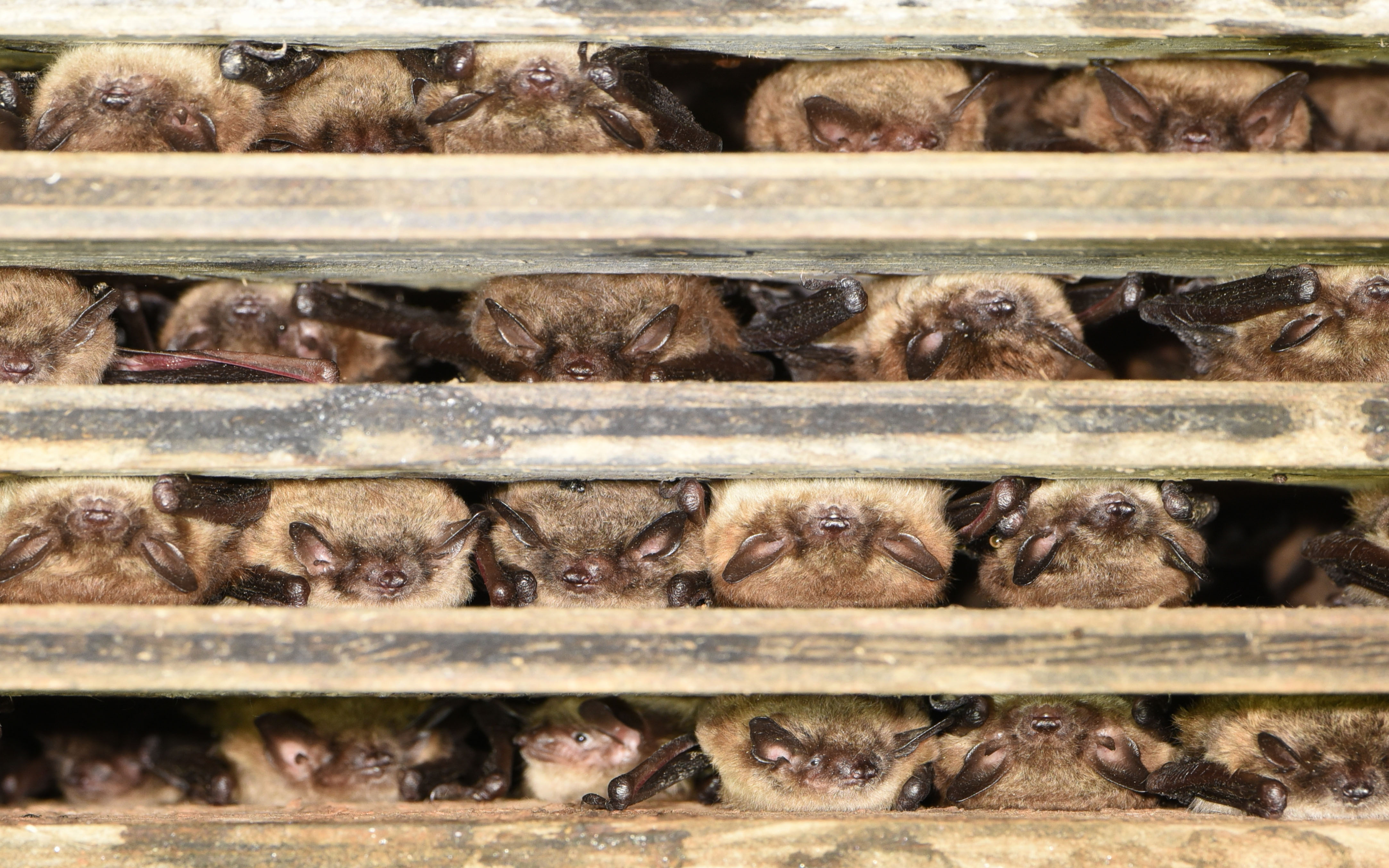
Your bat house should be installed so that: (1) the bottom is at least 10 or more feet off the ground, (2) in an open area free from obstructions, (3) oriented south-southeast (~140° azimuth), and (4) where it receives at least eight hours of direct sunlight. If there is an existing roost nearby with bats soon to be excluded, then the new bat house should be placed as close as possible (and ideally a season before the exclusion so bats may find it). However, it is not necessary to place the bat house on the existing roost for the bat house to be successful. If your bat house is occupied and you’ve decided after two seasons that you’d prefer to have your colony in a different location, you may move the house when bats are absent without causing the bats to abandon the bat house, as long as you move it to a location that receives the same daily solar exposure. Unfortunately, any bat house in the best location may go unused if there are many other available roosts nearby.
Photo at right: This ColonyLodge is located a few hundred feet from homes, near trees, but not shaded by the trees. This photo was taken in the late afternoon, showing the boxes receive direct sunlight nearly all day.
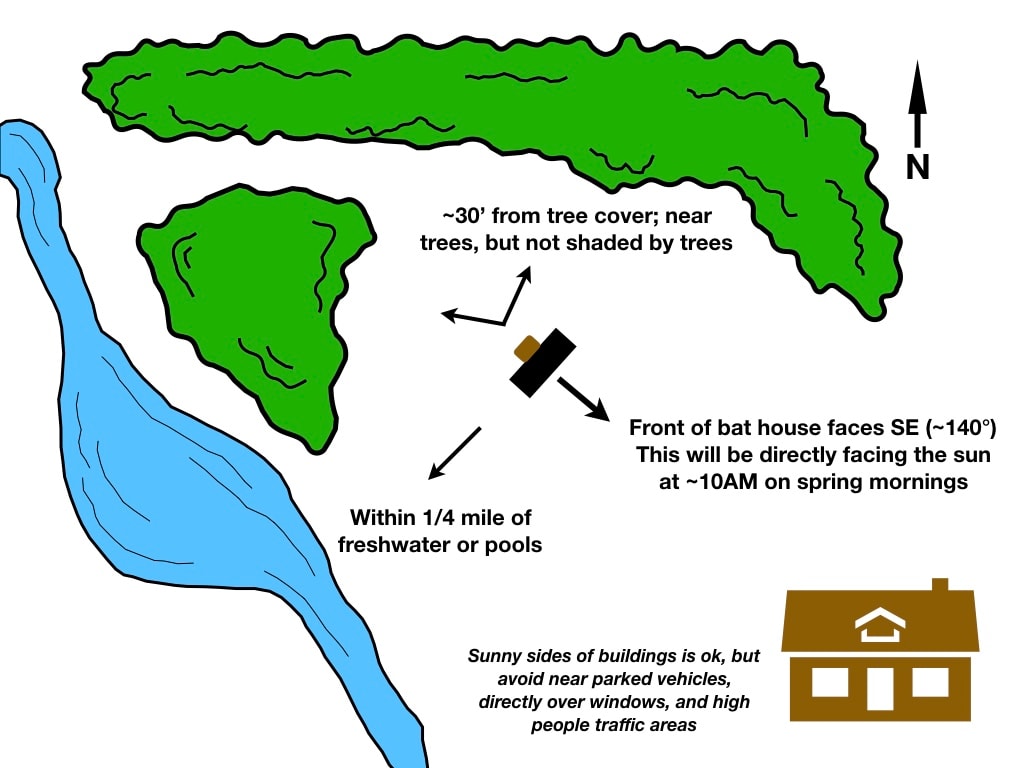
Bat houses are most attractive to bats if they are located within 1/4 mile of a permanent slow-moving stream, or pond. Bats will seek freshwater at dusk, and will capitalize on the readily available insect supply associated with the water and water-loving vegetation. Bats in some neighborhoods have even adapted to using swimming pools as watering holes while feeding on insects attracted to nearby outdoor lights. The bat house should be placed within 20-50 feet of a tree line or other protective topography to provide quick cover from predators such as owls. Place the bat house as close to trees as possible, but not where it can become shaded by trees. Take into consideration expected tree growth over the next 15+ years. Habitat diversity will also benefit bat activity in the area. A combination of forests, clearings, agriculture, and wetlands will produce different types of insects at different times throughout the night and over a season to accommodate a resident population of bats. Bats will probably not over- winter in bat houses, except in mild coastal, Gulf Coast, lower elevations of southern California, and other Southwestern states. However, they are quite loyal and will return to a bat house year after year as long as it continues to meet their needs.
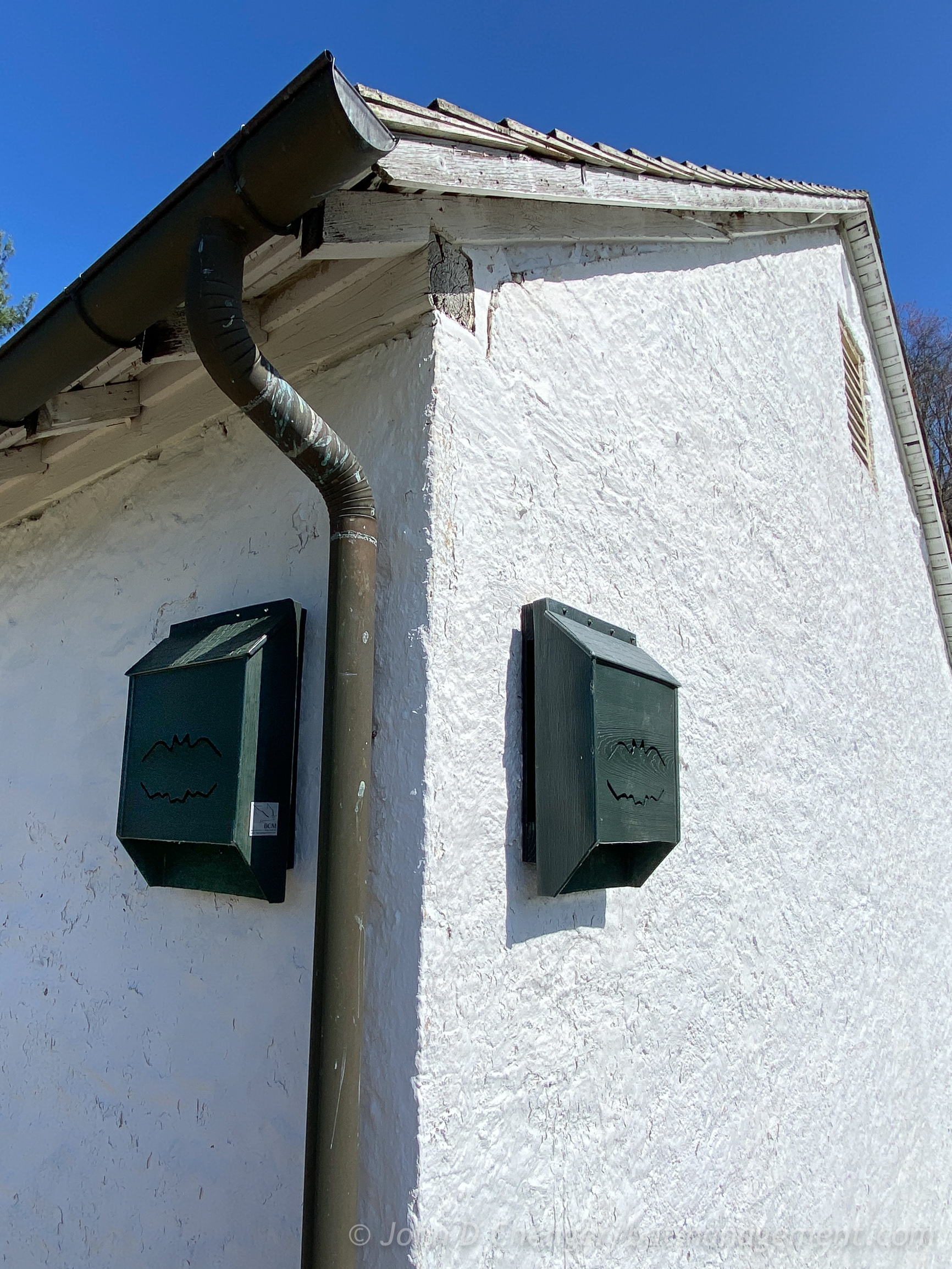
Receiving 8+ hours of direct sunlight, beginning in the morning.
Located in a diverse habitat with many vegetation types that support abundant insect prey.
Situated within 1/4 mile of freshwater (e.g., a still pond or lake, a smooth-flowing stream or river, a man-made pool or tank - even swimming pools).
Positioned near trees (or other topography that provides "cover" for bats flying to/from foraging grounds), but not shaded by trees in the morning.
Installed near an existing bat roost, especially if bats are soon to be evicted or the existing roost is going to be reclaimed or destroyed.
Oriented south-southeast to receive morning sun.
Airtight around the upper 2/3rds, with well-glued seams, especially at the roof.
Designed with a roughened interior providing secure gripping surfaces, especially for baby bats.
Placed so the bottom of the bat house is at least 10-feet off the ground. If expecting Mexican-free tail or Florida bonneted bats, consider 12’ or more.
Photo at right: consider installing several bat houses that receive different amounts of solar exposure, ideally one that receives direct sun especially in the morning and most of the day, and another that is sunny in the morning and shaded in afternoon. All bat houses, but especially small ones, greatly benifit from heat radiating off buildings.
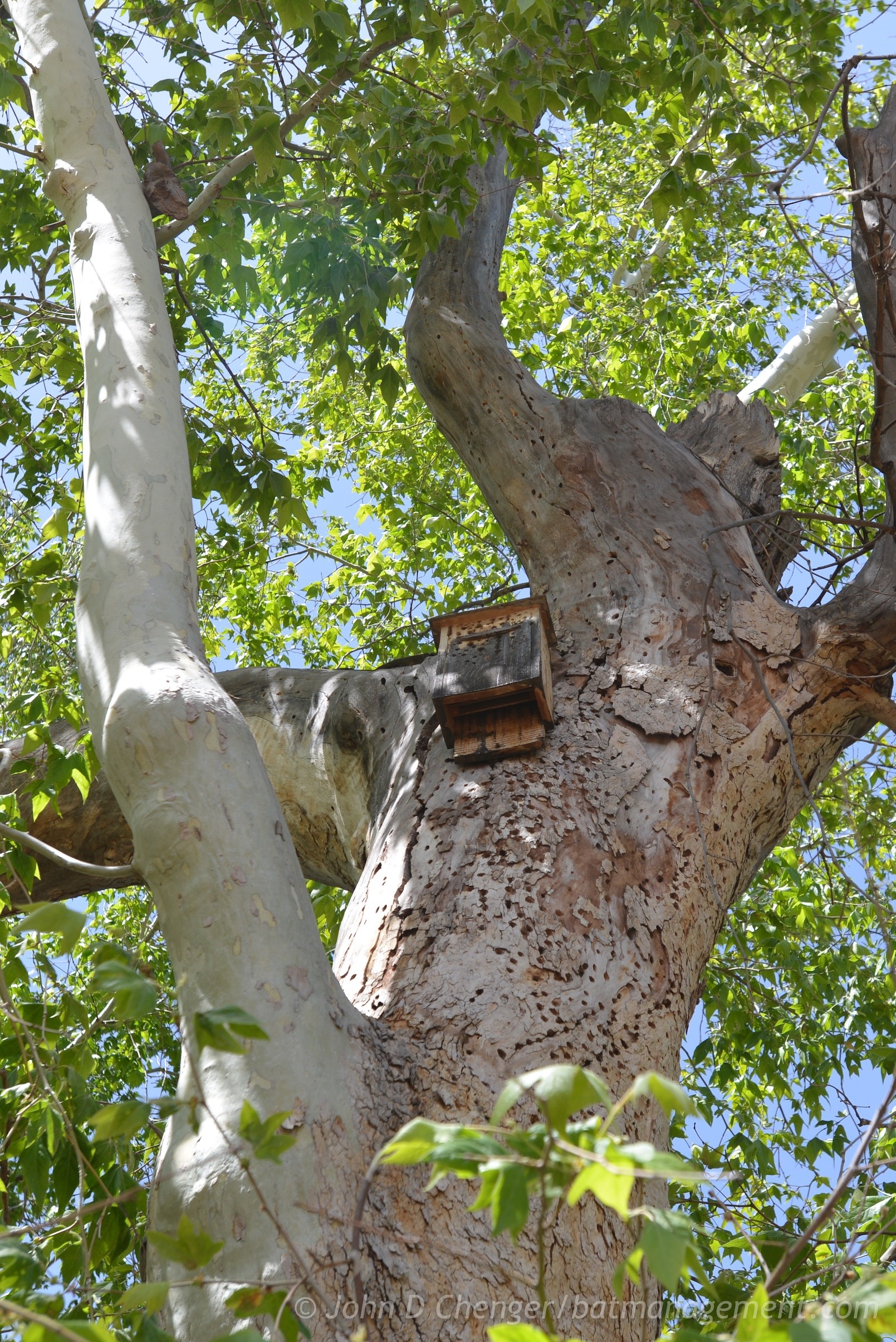
Placed in a shaded location, except in certain warm climate situations, or where experimenting with multiple bat houses is desired. Photo at right: example of a too-small bat house in a shaded tree which also became drilled by woodpeckers; needless to say no bats will be using it!
Mounted over bright or shiny surfaces that can reflect light directly into the box.
Located near fires or air exhaust where smoke or strong wind will disturb bats.
Installed where the box is prone to vandalism. Bats will abandon the roost or young will fall out and perish if the post is shaken repeatedly.
Set up where it may be repeatedly vibrated or shocked, such as if the mounting post receives regular impact from garden machinery.
Installed somewhere where light is directly shining on the the roost.
Situated on exposed hilltops or other windswept areas.
Positioned directly along or adjacent to roads. Bats swarm roosts at dawn and are vulnerable to automobile traffic.
Sited around high, thorny vegetation. Bats need room below and in front of the bat house to maneuver.
Mounted near where cars are parked; guano and urine will damage paint finish.
Mounted near a high traffic pedestrian area. Passersby may encounter grounded bats leading to unreasonable or sensationalized human health concerns. Consider fencing directly under bat houses at watchable wildlife attractions.
Note that no single situation above may be a deal-killer for your local bats, but avoid having a location where multiple problems persist.
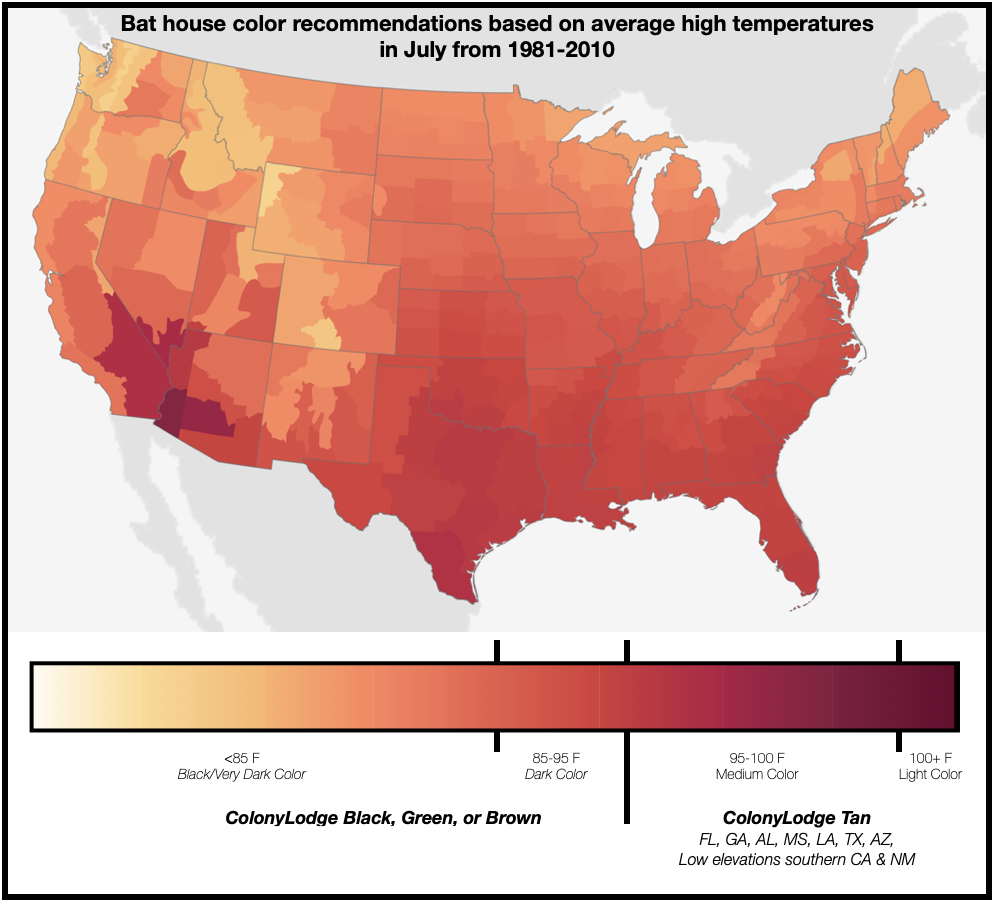
Temperature is a critical factor when bats consider a roost. Common bat house dwellers need temperatures around 95°F. While northern bats often need considerable heating in their roosts, southern bats, especially in lowland desert areas, may need less. Other than installing heaters and thermostats (which, believe it or not, some bat-loving folks have done), painting your house a suitable color to absorb heat and mounting it in direct sun is the best way to ensure a toasty warm roost. The amount of solar exposure needed to obtain the proper temperature range will vary slightly with local climate and elevation. The best advice when establishing artificial roosts in a new area, is to install several bat houses in different orientations, locations, and colors to learn what your local bats need.
Your most critical responsibility as a new bat house owner is also where you get to exercise your personal creativity. A finished wood house must be painted, stained, or sealed an appropriate color in order to seal micro-crevices and absorb heat.
The rest comes down to “location, location, location.”
In middle and northern latitudes, bat houses should receive a minimum of eight hours (preferably nine or more hours) of direct daily summer sun. Morning sun exposure is very important, especially during cooler days in early spring. Painting or staining the exterior of your bat house will almost always make it last longer. Dark brown or black stain on the exterior of bat houses in cool regions will significantly increase the temperatures inside the bat house. Use a quality exterior paint or stain designed to withstand weather and UV radiation damage. Note: it is still important to carefully caulk all exterior joints to ensure airtight seals, especially around the roof.
Houses intended for warm climates should be colored medium to dark brown, or in exceptionally hot places, light brown, white, or natural wood color of the bat house. Light colors may reflect the majority of solar heating away from bat houses. In all but the hottest desert environments, bat houses should receive at least eight hours of direct, unfiltered, morning sunlight. There’s nothing magic about shades of black and brown. Bat houses can be painted any color and adequate temperature gradients can be achieved with shades of green, blue, red, or your custom tone of choice. The exception is desert environments such as Tucson, AZ, where bat houses have only been successful when mounted on buildings in full shade.
Backyard Bat Houses
Learn the differences between our base bat houses suitable for starting backyard bat colonies.
Siting and Color
Consider the options on where to locate your bat house so it's good for bats and -for you-.
Installing a Bat House
Trees, buildings, or poles?
Installing a bat house on something high can be a job, here are suggestions on how to move it along.
Maintaining a Bat House
Our bat houses are low maintainance, but there are some long term situations to be aware of.
Human Health Concerns
Bats attract more than their fair share of negative press, here are some facts to help prospective bat landlords rest easier.
Can my bat house be too hot?
Advice from real-world experts on how to recognize when is too hot, when to be concerned, and how to mitigate.

